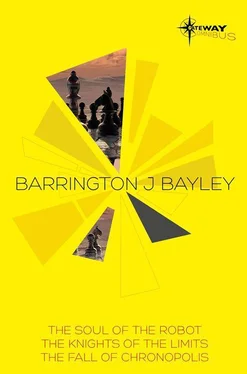‘The odd thing is,’ said the priest slowly, ‘that their perversion is probably of a spiritual character only. It has been found that heretic chronmen are nevertheless loyal to the Time Service. That part of their oath remains sacred to them.’
A signal sounded on Aton’s desk. A burry voice spoke from the annunciator.
‘The following vessels will break off and engage the enemy. Exorcist, Smasher of Enemies, Emperor’s Fist, Incalculable …’ Aton counted twelve names in all, the same number that made up the enemy’s squadron. This was necessary, probably, if the Hegemonics were to be persuaded to stand and fight rather than to flee home without accomplishing their mission.
The Smasher of Enemies swung away from formation. The Hegemonics disappeared from the scope screen, then came back after a brief interval, even more blurrily, as the destroyer picked them up on her own less powerful radar.
The established procedures of attack swung into action. One of the bridge controllers was getting in touch with the rest of the attack squadron. At the same time beta contact beams sped ahead of their flight path, seeking out the enemy and offering negotiation.
Comforter Fegele retreated to one side and was heard muttering prayers and blessings, dipping his hand into his chalice occasionally and sprinkling a token amount of wine on to the deck.
As soon as they became aware of their pursuers the Hegemonics put on speed and went into evasion manoeuvres. The wedge-shaped ships, five times taller than they were broad or long, multiplied into a series of fading prismatic images, like a multiple exposure, as they changed direction. The pilot of the Smasher of Enemies , snuggled into the nose of the bridge, also put on a surge of velocity, taking them close to the maximum. Before Aton’s eyes the forward end of the bridge diminished in size; the pilot became a midget, a boy-like figure, then a puppet no more than six inches high.
The flight of the Hegemonics failed to outdistance the ships of the Chronotic Empire, each of which was now picking out an adversary. The Smasher of Enemies vectored in on a dancing wedge. It was difficult, sometimes, to sort out the flickering images from the wavering curves of the strat as they also showed up on the scope screen, but Aton never lost sight of it entirely. He issued a clipped order to the pilot.
The destroyer plunged forward in a new burst of speed until she overtook the Hegemonic craft and swung around to place herself directly in its path. The pilot rushed the ship back and forth, veering in close to the enemy and setting up a wash of discomfiting strat waves. In answer the Hegemonic darted away and tried to weave a path past the obstacle, but the pilot stuck close.
The beta operator depressed a switch and leaned forward to speak into a microphone. ‘Hello, gunnery. You have contact.’
The tense voice of Sergeant Quelle sounded on the bridge and was relayed by beta ray to his counterpart on the Hegemonic war craft.
‘Stand and fight; stand and fight,’ he ground out in a gravelly tone. ‘Here is our proposed location.’ He repeated his words in the Hegemonic language, while at the same time a string of recorded co-ordinates was beeping out on the beta beam.
After a delay of only seconds came a terse answer: ‘Agreed.’
The two ships sped away on nearly parallel courses, slowly diverging until they were both faint on each other’s scopes.
The front of the bridge ballooned in size as they slowed down. The pilot leaned back, his hands lifting from the controls; the steering-board was now under the control of gunnery.
A curious but necessary tradition of collaboration existed among warring timeships. The self-powered torpedoes they carried, though deployed as a matter of course, were so slow and cumbersome, so much at the mercy of strat disturbances, as to be nearly useless. To be effective a warship needed to employ its heavy-duty beamers.
But because no pure energy could travel in the strat this meant phasing into orthogonal time. A timeship that stayed in its natural medium could neither fire on, nor be fired on by, another timeship. For that reason ships willing to join battle agreed on a rendezvous where each, by leaving the strat, made itself vulnerable to the other.
The tryst (as it was dubbed) had to be both precise and momentary: a point in time without duration. How long a warship lingered beyond that instant in passing time was entirely a matter of discretion, comprising a ratio between estimated survival time and the minimum time needed to locate the enemy and focus weapons upon him. The tendency was towards microseconds, during which each combatant discharged a massive broadside. That, very often, was the end of the battle. A heavily damaged ship would be reluctant to emerge again from the protection of the strat but would try to return home.
All of which explained the crucial importance of the gunnery crew, who made these calculations.
On his desk Captain Aton watched the countdown to emergence in orthogonal time. The suspense was almost unbearable, yet in a way the battle was a non-event – one could not keep track of it in time, since it was all over in a flash. There was only the aftermath, either triumphant or dreadful.
While the minutes and seconds ticked off, the gunnery crew would be priming their comps for those vital microseconds. The battle bracket itself, too small for human consciousness, would be handled by the comps. Afterwards would come the frantic damage assessment by the bridge, reports, if available, on damage inflicted on the enemy, and a decision as to whether or not to offer a second tryst.
Gunnery made an announcement: ‘Entering ortho five seconds from now .’
The whole bridge waited in tense silence.
Then the Smasher of Enemies shook violently, reeled, and swayed as if spinning. Even without studying the damage board closely, Aton could see that something searing had penetrated her vitals.
He glanced up at the scope screen. The Hegemonic ship had reappeared there and was executing a peculiar-looking sideways manoeuvre. Its nearer wall was stained and bubbling.
Gunnery had scored a hit.
Voices came babbling into the bridge. Then, to his surprise, Aton glimpsed a second wedge shape hovering some distance away on the edge of the screen.
Sergeant Quelle’s hoarse voice came through to him on his desk com. ‘They tricked us, Captain! We were fired on by two ships together – caught in between ’em!’
Aton cursed. ‘Evidently a new tactic,’ he said wryly to Quelle. And a treacherous one: this sort of conduct was contrary to the unstated rules of temporal war.
He turned to listen to the damage reports. An energy beam had struck the destroyer’s flank, penetrated its inner armour, and burned a swathe reaching as far as the drive-room. Luckily the damage in the latter was less than total: the drive was still operating, though the orthogonal field that maintained normal time inside the ship while it travelled the strat was weakened.
Next he turned his attention to news of the rest of the battle. About half the Chronotic timeships had so far engaged the enemy. On balance, events seemed to be going their way. Two Hegemonics had already been destroyed.
His lieutenant leaned towards him. ‘It would be risky going into ortho again, Captain.’
Aton nodded, feeling the weight of responsibility. This was more than a skirmish: the existence of the city of Gerread depended on it, as well as the Chronotic control of a whole segment of history.
‘I’m afraid we shall have to take that risk, Lieutenant. Those ships have to be stopped.’
His voice rose. ‘Scanman, there are two enemy vessels in our vicinity. Range them both for gunnery.’
Читать дальше












